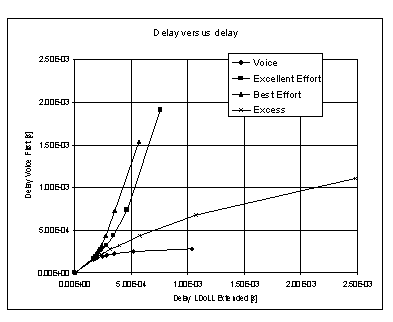
Both LDoLL Extended and Voice First Queuing support multiple priorities. Too compare these two queuing systems, a series of simulations was made to compare them. The most remarkable observation is that LDoLL Extended can perform almost as well as Voice First Queuing, as long as all the settings of LDoLL Extended are set perfectly. LDoLL Extended has an advantage over VFQ because it allows multiple priorities, without the risk of one starving the other.
The can be seen in the following graph, which shows the performance of LDoLL Extended versus the performance of VFQ. For different loads, the delay suffered for each of for traffic types is recorded. The delay using LDoLL Extended and the delay using VFQ is compared by plotting both on a separate axis. This means that the close a point is to the LDoLL Extended axis, the better the performance of VFQ is.

The lowest trace in the graph shows the delay suffered by voice. Except for the last two points (which indicate loads of 0.9 and 0.95) all points show more or less the same delay for LDoLL Extended and VFQ. For the higher loads, the delay with LDoLL Extended increases a little while the delay with VFQ stays more or less the same.
When we look at Excess traffic however, we see that VFQ gives this traffic type a far better QoS than LDoLL Extended does. Of course, we don't want excess traffic so this is actually an advantage of LDoLL Extended.
Since our queues are work-conserving the higher delays voice and especially excess suffer in LDoLL Extended should lead to lower delays for other traffic types. Indeed, Excellent and Best-Effort suffer considerably lower losses using LDoLL Extended compared to Voice First Queuing.
Copyright © 2000 Philips Business Communications, Hilversum, The Netherlands.
See legal statement for details